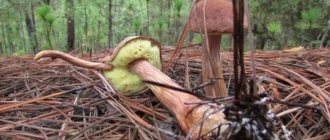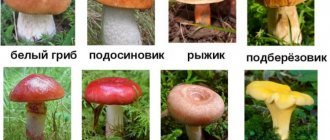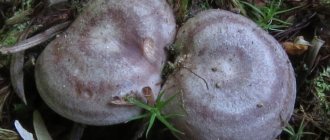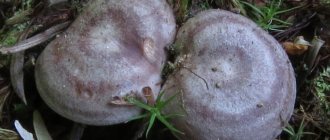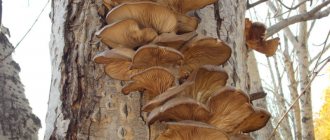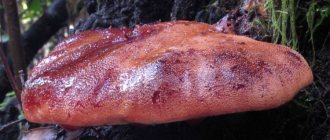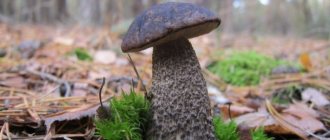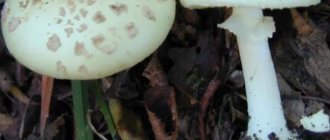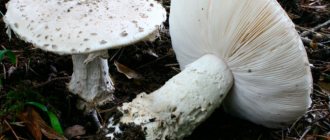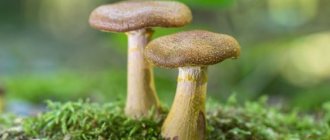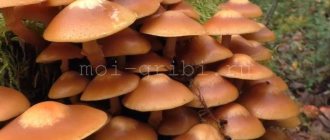Almost all mushroom pickers have seen hedgehog mushrooms, which resemble chanterelles from above. But only a few people dare to collect them. It's scary to put a toadstool in your cart by mistake! Mushroom pickers who know these mushrooms sometimes don’t take blackberry mushrooms because the brittle needle-like outgrowths on the back of the cap quickly crumble and stain the rest of the mushrooms. It is best to collect edible hedgehogs while they are young.
Yellow hedgehog, photo from Wikipedia
Types of these mushrooms, appearance
Variegated hedgehog mushroom (Hydnum imbricatum, Sarcodon imbricatum) is an edible species of mushroom that is most often found in pine forests. The hedgehog's cap is quite large, brown in color and quite massive in shape. On top it is covered with large scales that lie like tiles. Small mushrooms have a darker cap, which gradually becomes brown, and then completely brown-black. The lower part of the cap is covered with white spines, which over time become more brown or even rusty-gray in color.
The leg of the hedgehog is exactly the same as the cap. But sometimes you can find mushrooms with purple stems.
The flesh of the motley hedgehog is whitish; when the mushroom gets older, it becomes dirty gray. Young mushrooms have dense and juicy flesh, while mature mushrooms have hard and dry flesh. That is why it is better to eat the variegated hedgehog when the mushroom is still young. The smell of mushrooms is quite specific and spicy, and the taste is bitter. And the older the mushroom, the more unpleasant the smell and the more bitter the taste it acquires.
Similar species
- Pineal fungus.
The name speaks for itself - its cap, like that of the hedgehog, is covered with overlapping scales, which makes it look like a spruce or pine cone. This mushroom is easy to distinguish from the hedgehog mushroom; its spore-bearing layer is tubular, not needle-shaped. The mushroom is edible.
- Finnish hedgehog.
An inedible mushroom that differs from the variegated hedgehog in its smaller size. In addition, the flesh of the leg is dark, has a strong pungent taste and peppery aroma.
1- Pineal fungus. 2- Finnish hedgehog.
- Rough hedgehog.
Conditionally edible. It differs from its motley “brother” in having a lighter colored cap and much smaller scales on the cap.
- Sarcodon amarescens.
Another inedible representative of hedgehogs does not have a Russian name. The difference from the motley hedgehog is that the base of the leg is painted blue-black. The mushroom is bitter, but not poisonous.
1- Rough hedgehog. 2- Sarcodon amarescens.
Where, when and how does it grow
Variegated hedgehog is one of the autumn mushrooms, as it begins to grow and grows closer to autumn. The approximate time when it grows is from August to November. In some areas this type of mushroom is called "elk" or "chicken". The mushroom grows on the soil, in dry pine and coniferous forests, and is rarely found in mixed forests. It forms mycorrhiza, mainly with needles.
Also, variegated hedgehog can be found in sandy soils. It often grows in groups of up to five copies, but is even more often found one at a time. If we talk about the species that are most similar to the variegated hedgehog, we can highlight the following:
- sarcodon glaucopus - a mushroom with a smooth cap and a blue stalk at the base;
- rough hedgehog (sarcodon scabrosus) - a mushroom with a light cap and pressed scales, conditionally edible;
- yellow hedgehog (hydnum repandum) - a mushroom that is most similar to the variegated hedgehog, especially specimens faded in the sun;
- pineal mushroom (strobilomyces strobilaceus) is a very rare mushroom that has a variegated scaly cap.
Some interesting facts about variegated hedgehogs
Variegated sarcodons tend to fade in the sun. They become a color similar to yellow hedgehogs. However, these mushrooms are not related. What they have in common is only the same structure of the spore-bearing layer.
Despite the similarities, the pied sarcodon is not related to the yellow hedgehog
Scientists have obtained a large number of useful components from hedgehogs, but they are not yet officially used in pharmacology. All substances undergo laboratory testing. For medicinal purposes, the mushroom is used only by fans of traditional medicine.
More information about mushrooms can be found in the video:
Benefit
The beneficial properties of hedgehog mushrooms have not been fully studied, but there are already several studies that confirm that consumption of these mushrooms helps fight senile dementia. In addition, hedgehog mushrooms help fight leukemia - these mushrooms can be used as a natural substance for the prevention of cancer.
The mushroom is used as a remedy that helps cure inflammation, heal wounds and get rid of warts. Many of the mushrooms of this species are used in medicine, but not the variegated hedgehog. But its fellow yellow hedgehog just helps to strengthen the body and renew the blood; in addition, medicinal ointments and masks are made on the basis of this mushroom, which in turn help get rid of various diseases on the skin and restore the tone of the skin.
Medicinal properties of variegated hedgehogs
In addition to cooking, variegated hedgehog is used in folk medicine in the treatment of many diseases, as well as simply to maintain vitality. The pulp contains useful substances such as campesterol, glutamic, nicotinic and aspartic acid, as well as potassium.
The popularity of the motley hedgehog among traditional healers is due to the many beneficial properties of the mushroom.
If we take a closer look at the variegated hedgehog, its benefits extend to many vital human organs:
- The mushroom contains antibacterial substances. The juice squeezed from the pulp disinfects the wound and eliminates the inflammatory process. The mushroom is a natural first aid kit for mushroom pickers; it helps provide first aid in case of injury or infection with E. coli.
- Athletes are recommended to consume blackberries during active activities. Nutrients help build muscle mass and increase vitality.
- Traditional healers use the mushroom to relieve symptoms of depression, improve sleep and mood, and calm the nervous system.
- The acids contained in the composition help remove cholesterol and toxins from the body. There is an increase in the production of red blood cells, which improve the blood formula. The walls of blood vessels become elastic.
- The mushroom has a positive effect on the human body and hair. The skin restores elasticity and natural shine. Hair becomes silky.
Ancient healers knew about the benefits of hedgehogs. The surviving treatises of Chinese doctors contain many recipes for preparing healing tinctures and ointments. Rejuvenating face masks are prepared based on variegated sarcodon.
Application
The variegated hedgehog is considered a conditionally edible mushroom and, in general, it is of rather mediocre quality. Young mushrooms can be processed in any form - this can be salting, pickling, drying, and so on. The bitter taste inherent in this species disappears after the mushroom is boiled (this should always be done before processing if the mushroom is conditionally edible).
Old mushrooms are tougher, their taste is bitter, and they themselves become unsuitable for consumption. Moreover, in its raw form, the old motley hedgehog can be very poisonous.
In cooking
And although the variegated hedgehog is not considered a very popular mushroom for consumption, it is still often prepared and consumed by those who have full access to mushroom harvesting. In reference books, the yellow hedgehog is described as a very tasty mushroom. Due to the fact that yellow and mottled hedgehogs are similar, they are often confused and cooked incorrectly. Before you cook this type of mushroom, make sure it is what you think it is.
Before placing the mushrooms in a saucepan or frying pan, the spines must be removed. During cooking, they will fall off on their own, which is why you will not get fried mushrooms, but porridge or soup. Blackberries must be boiled in salted water before cooking. Place the mushrooms in boiling water for 2-5 minutes and then cook them as planned.
They can be fried, baked, pickled, dried and pickled. When fresh, they are not prepared as a separate product, but are most often mixed with other mushrooms.
Growing at home and in the country
Blackberry does not lend itself well to industrial cultivation and, moreover, has a very specific, pronounced spicy taste, so it has not received wide recognition in cooking. But true connoisseurs can easily grow this mushroom in their summer cottage. Planting material is purchased in specialized stores. It consists of wooden sticks with spores.
Sarcodon imbricata can be planted in open ground from April to October, in protected ground - at any time of the year. Spores germinate in wood. Recently felled logs, cleared of shoots, are good for this. The length of such a beam must be at least 1 m and the diameter 15–20 cm.
Before transferring the planting material into the wood, it is soaked and holes 4 cm long and about 1 cm in diameter are made in it every 10 cm. After planting the mushroom sticks, the logs are covered with film and placed in a warm, dark room. Water 2-3 times a week.
After the mycelium appears, the decks are brought out into the light. After 5-6 months the harvest will appear. For the winter, you need to organize a shelter over the log.
IMPORTANT! When working with planting material, you should either wear sterile gloves or pre-disinfect your hands.
Harm and contraindications
Regular consumption of the mushroom may cause certain problems, especially for people with high sensitivity. Allergies and asthma attacks may occur.
Variegated hedgehog is completely contraindicated in case of individual intolerance to the product. It is also prohibited for use by breastfeeding and pregnant women. It should also not be eaten by small children and people who have problems with the digestive system. This is due to the fact that mushrooms themselves are a fairly heavy product, which puts a strong strain on the entire gastrointestinal tract.
Description of the yellow or notched hedgehog (Hydnum repandum)
Hat. The “calling card” of the hedgehog is its matte cream hat. More precisely, the underside of the cap is strewn with pointed outgrowths-needles, which easily break off. They are the same color as the cap, sometimes a little lighter. The size of the cap (usually from 3 to 12 cm in diameter) can be up to 20 cm. It is hard, but brittle.
The caps of young mushrooms are convex in shape, with age they open, after which they become depressed and acquire some depression in the central part. You can often see mushrooms with an irregularly shaped cap. The edges of old hedgehogs curl inward. The cap of young mushrooms has dense flesh with a pleasant aroma. In old mushrooms, the flesh becomes reddish. A layer of plaque or slight pubescence is noticeable on the skin of the hedgehog cap. In some places, yellow hedgehogs are found not with whitish-cream flesh, but with dirty rusty flesh.
Leg. The leg of the yellow hedgehog is quite thick (up to 2.5 cm), sometimes elongated (up to 6 cm). Sometimes its base (near the ground) is expanded. The monochrome leg of the hedgehog is usually lighter than the cap,
Yellow hedgehogs grow on any soil in deciduous, coniferous and mixed forests. Sometimes mushrooms form “witch circles.” The first hedgehogs are collected at the beginning of summer, usually from July. Mushrooms grow until autumn frosts, often until September.
Preparation and storage
Fresh variegated hedgehog will not be stored for long. After just a few hours at room temperature, the mushroom will begin to darken, so it should be immediately placed in the refrigerator or cooked within 3-5 hours after collection. If it is not possible to cook the mushrooms right away, they can be stored in the refrigerator. The mushroom will be in normal condition for about 3 days, but then it will definitely need to be processed. However, even before placing mushrooms in the refrigerator for storage, they need to be prepared. Here are simple rules that will help you avoid making mistakes:
- Wash the mushrooms and soak them in salt water for several hours. This will help remove pests from the mushrooms.
- Dry the mushrooms and remove any damaged areas on the stem and cap.
- Place the mushrooms in a deep bowl. Cover with a napkin tightly enough so that nothing comes into contact with the mushroom.
Since mushrooms absorb other odors very quickly, they do not need to be stored with other products. But hiding mushrooms in a plastic bag is also prohibited. To store mushrooms for a long time, use pickling. They can be stored frozen, but even here the time will depend on the temperature. For example, at home, at a temperature of -12 degrees, mushrooms will be stored for up to three months, at a temperature of -18 degrees for up to six months, and at a temperature of -24 degrees for up to a year.
How to cook motley hedgehogs
After harvesting, the harvest must be carefully sorted again. Repeated sorting helps to identify randomly collected pied hedgehog doubles and old specimens. Only young mushrooms are left for cooking.
Important! Many sources contain information that old hedgehog mushrooms are completely inedible. The statement is true.
Before cooking, young hedgehogs are cleaned of thorns and dirt, washed for up to 20 minutes in clean water and boiled. You can dry the harvested crop so that you can cook soups, sauces and other dishes all winter.
Cleaning and preparing mushrooms
During cleaning, many mushroom pickers try to completely remove the unusual, needle-like spore-bearing layer and clean the surface of the cap. In fact, such a procedure is optional. It is enough to rinse motley sarcodons thoroughly in clean water using a brush. During washing, dirt, sand, adhering pieces of grass and leaves are removed from the surface of the pulp. Most of the needle-like protrusions will fall off on their own due to friction. The remaining spikes after cooking are not felt in the mouth as solid formations.
The needle-like spore-bearing layer does not have to be removed when cleaning the cap.
How to fry
Before frying, variegated sarcodons are thoroughly washed. It is important to get rid of the remaining mycelium, dirt, and sand. To be safe, the mushrooms are soaked and then boiled for about 20 minutes in salted water. The finished mass is discarded in a colander. When all the water has drained, the sarcodons are fried in a frying pan with the addition of sunflower oil.
Fried motley blackberries are delicious in sunflower oil or with sour cream
Advice! You can use any vegetable oil for frying, but it is fresh unrefined sunflower oil that gives the dish a piquant taste.
When the fruiting body of the fried mushrooms has softened, add the onion, cut into rings, into the pan. At this stage you need to salt the dish. Continue frying with the lid open until all the juice has evaporated. If the liquid has evaporated and the mushrooms are still raw, cover the pan with a lid. Ready-made variegated sarcodons will darken slightly. A pleasant mushroom aroma will begin to emanate from them. If desired, you can add sour cream to the blackberries a couple of minutes before the end of frying.
How to marinate
For marinating hedgehog mushrooms, it is best to use 720 ml jars. For one such container you will need the following ingredients:
- motley sarcodons – 0.5 kg;
- one onion and a clove of garlic;
- 1 tbsp. l. salt and sunflower oil;
- 2 tbsp. l. vinegar 5% or 1 tbsp. l. vinegar 9%;
- about 10 black peppercorns and 1-2 bay leaves.
To prepare the marinade, one jar requires 250 ml of boiling water.
Pickled variegated sarcodons are ready to eat in 24 hours
The washed and peeled blackberries are poured with boiling water for 15 minutes, after which they are left to drain in a colander. All ingredients, except bay leaf, are placed in a jar. Pour in 100 ml of boiling water. The jar is filled to the neck with prepared variegated sarcodons. A bay leaf is placed on top. The remaining boiling water is poured into the jar so that the water completely covers its contents. The lid is used with a twist or plastic, which depends on the neck of the container. The jar of mushrooms is turned upside down and, after cooling, placed in the refrigerator. A day later, pickled blackberries are served.
How to freeze
Before freezing, motley hedgehogs are cleaned, but not washed, otherwise they will become saturated with water. Mushrooms are frozen in bags or plastic containers, distributed into the required portions. The storage duration depends on the freezing temperature:
- — 12 оС – 3 months;
- — 18 оС – 6 months;
- — 25 оС – up to 1 year.
After defrosting, the mushrooms are subjected to washing and other preparatory procedures.
Frozen mushrooms are stored in a bag or plastic container
How to dry
To dry mushrooms, it is similarly undesirable to wash them. The exception to the rule is their further purpose. If dry variegated blackberries are ground into powder for seasoning, they must be washed before drying. The crushed flour cannot be washed in the future, and sand from dirty mushrooms may remain in it.
Dried mushrooms can be stored whole or ground in a coffee grinder into powder for seasoning.
If the blackberries are stored whole, you can wash them before using them for cooking. Mushrooms are dried naturally, spread out on a tray or strung on a thread. For quick drying, use an oven, microwave or dryer.
Canning
For long-term preservation of the crop, preservation is best suited. The ingredients are the same as for marinating. Just do not pour boiling water over the spices, but cook a marinade from them. The jars are sterilized by steaming or heating in the oven. Sealing is carried out using metal lids. Store preserved food in a cellar or cool basement. In urban environments, a balcony is suitable.
Canned blackberries can be stored for up to 1 year
Beneficial features
Hedgehog is an ordinary mushroom that helps to cope with many problems:
- has antibacterial properties, provides protection against E. coli, staphylococci, its juice can be used to treat a cut wound;
- quickly increases muscle mass when consumed during intense training;
- tones, adds strength and energy;
- charges with positivity and removes depression;
- improves sleep;
- removes toxins;
- improves lung function, increases lung volume;
- nourishes the body with useful substances - thanks to it, hair and nails begin to grow faster;
- improves blood quality and accelerates its circulation.
general description
The blackberry belongs to the Hericiaceae family, the order of the fungus is Russulaceae.
Mushrooms are unique creatures of nature, because it is not for nothing that their own kingdom of living nature is reserved for them. Some of them can be extremely beneficial for human health, while a certain part can have a detrimental or even fatal effect on human life. You need to be very careful when choosing foods to eat. In this article, we will look at Blackberry (which has many other names), which can improve brain function and benefit cancer.
Very often, people call the combed hedgehog “blackberry,” so this name has taken root, and now it can be found in many sources. In Latin it is called Hericium erinaceus.
The mushroom has a very original, interesting, specific and memorable appearance, which could undoubtedly take one of the first places in competitions for the most exotic appearance.
The most pressing questions and answers to them
Is it possible to give hedgehog mushroom to children? Blackberries, like other representatives of mushrooms, are considered difficult to digest and assimilate food. Therefore, you should not give them to children under 5-6 years old.
Is the hedgehog edible if it grows near poisonous mushrooms? Under no circumstances should you collect hedgehog mushrooms that are in contact or have their caps fused with other mushrooms. Poisonous spores from dubious neighbors can end up on the caps of edible plants. It is especially dangerous if pale toadstools grow nearby, containing amanite poison, which does not dissolve even with heat treatment.
Can blackberries be eaten raw or half-raw? When eaten raw, they are too bitter, and variegated hedgehog can cause serious food poisoning, so before eating they must be boiled for at least 10 minutes and the broth drained.
Hedgehog mushrooms is a general name for a group of mushrooms, distinguished by the presence of characteristic spines (needles) on the lower part of the cap, but at the same time classified into different classes, orders and families. In terms of their taste properties, they are considered low-grade, so they are not cultivated. Despite this, in some European countries these mushrooms are considered a delicacy and are especially appreciated by French gourmets.
You can meet representatives of this group only in the wild, and some species are so rare that they are protected by the Red Book. Unlike cooking, hedgehogs are very valuable for pharmacology and medicine and are widely used in the treatment and prevention of many diseases.
Benefits and nutritional value of mushroom
Due to its composition, the mushroom boasts a high content of fiber, carbohydrates and proteins. It also contains all the necessary macroelements and microelements. The energy value of 100 grams of mushroom is 22 Kcal.
Vitamins contained in blackberries:
- vitamin RR,
- vitamin C,
- ryboflavin,
- vitamin B4,
- pantothenic acid,
- betaine,
- vitamin D,
- vitamin D2,
- vitamin K
As for microelements and macroelements, in blackberry they are as follows:
The product also contains:
- aminopropanoic acid,
- diaminohexanoic acid,
- leucine,
- glutamic acid,
- aminosuccinic acid.
Due to its unique composition, the mushroom is actively used in folk medicine. Active components that help cure many diseases:
- Campesterol. In its structure, this substance resembles cholesterol. When the substance enters the body, it mixes with bad cholesterol, this promotes natural release from the human body.
- Glutamic acid. Thanks to it, the taste of the mushroom becomes piquant, restores muscle tissue and is a source of energy.
- Aspartic acid. Normalizes the functioning of the endocrine system; it is also a growth hormone.
- Potassium maintains the body's water balance, also improves heartbeat and normalizes blood pressure.
- A nicotinic acid. Takes an active part in protein synthesis and energy metabolism.
Growing
A large number of wild mushrooms, including hedgehog mushroom, are difficult to grow artificially, so very rarely people wonder how to grow a hedgehog mushroom with their own hands.
The easiest way to grow a mushroom is to buy ready-made mycelium, which is sold in stores, on the Internet and on official websites. If you plan to grow mushrooms outside, then planting should take place from April to October. This type of mushroom feels great indoors, so it would be advisable to breed hedgehog mushrooms in a basement or shed, where they can grow all year round.
How to grow a hedgehog:
- First, you should cut down a deciduous log, which must not be rotten.
- The branches can be cut, but the bark cannot be touched; the wood must be wet.
- The wood is left in a warm, ventilated area for 7 days.
- Next, you need to drill a hole with a diameter of 1 centimeter and a depth of 40 millimeters. Several such holes need to be made in a checkerboard pattern.
- It is in these holes that the mycelium is placed.
- Wrap the logs in plastic with holes so that the wood can breathe.
- The logs are transported to a warm room where the sun's rays do not penetrate; it must be watered three times a day so that moisture does not disappear.
- As soon as the first threads of the fungus appear, the wood is placed in cold water for a day.
- Next, the chocks are moved to a bright room and placed vertically.
At the end of autumn, the chocks are covered with leaves or placed in the basement. The first harvest will be in 6 months, then the mycelium needs to be watered only occasionally for two weeks. Next, collect mushrooms as they grow, and it is better to collect young mushrooms.
There are only four types of hedgehog mushroom, each of them is unique in its own way. Some varieties are of great benefit to the body, but mushrooms should not be overused, since they are a heavy product. Before going into the forest to pick mushrooms, you should study all the mushrooms in detail, so as not to pick a poisonous mushroom due to inexperience and become poisoned by it.
Variegated hedgehog.
The fungus is widespread in conifer and spruce forests. He likes sandy soil. It grows solitarily, sometimes there are groups of three to five specimens. Mushroom pickers consider it an autumn mushroom. It grows successfully until the first snow appears.
- The large cap grows up to 20 centimeters. The color of the cap is brown. Closer to the center the brown color darkens. A ripe mushroom has a flat cap that is slightly depressed in the center. It is dry and hard to the touch and is covered with thick dark scales. The scales are easily separated from the cap. The edge of the cap is wavy and curved inward. At the bottom of the cap there are whitish needles. Over time, the color of the needles becomes gray.
- Young mushrooms have dense white flesh with a yellowish tint. Mature mushrooms have hard, brown flesh.
- The strong leg is dry to the touch. At the base it widens quite noticeably. The solid stem becomes hollow when ripe. At the top the leg is colored in the color of the cap, at the base it is brown.
Eating hedgehog mushrooms.
These mushrooms, when eaten, do not delight anyone, but they will not let you die of hunger. Only young mushrooms can be cooked. Due to the lack of taste, the mushrooms are cooked with other, more flavorful mushrooms.
Before cooking, you must remove the needles from the bottom of the cap. If this is not done, the needles will fall off the mushroom and the whole dish will turn into an unpleasant mess. Mushrooms can be dried successfully.
They were assigned the fourth category. Mushrooms have a wonderful property - you can’t get poisoned by them!
